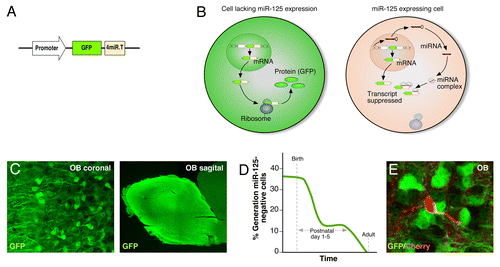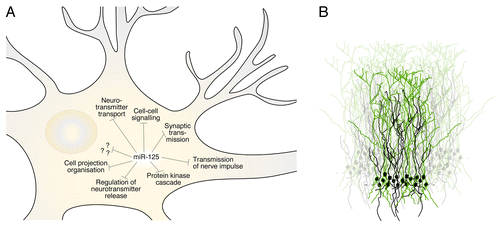Figures & data
Figure 1. miR-125 transgenic sensor mice reveals developmental origin of miR-125 negative cells. (A) Schematic illustration of the proviral form of the miR-125 regulated sensor vector. (B) The miR-125 regulated lentiviral vectors are present in all cells of the transgenic animal. If no miR-125 is present in the cell, the vector mRNA is translated into protein and GFP is expressed. On the contrary, if miR-125 is present it binds and suppresses the transgene mRNA, hence, no protein is formed and no GFP is expressed. (C) A coronal and sagittal OB section demonstrates lack of miR-125 activity in interneurons in the OB. (D) Percentage of miR-125 negative cells generated over time. BrdU was injected to the transgenic sensor mice at different time points (ranging from E17.5 to adult) and the number of BrdU/GFP double positive cells in the OB was counted. (E) Adult-born interneurons labeled with Cherry lacks GFP-expression. A Cherry-expressing lentivirus was injected into the SVZ of P3 mice pups to target the neural stem/progenitor cells. The mice were sacrificed 8 wk after injection.

Figure 2. miR-125 controls a large set of genes related to synaptic functions and dendritic morphogenesis. (A) Illustration of Gene Ontology classes enriched in miR-125 target genes, identified using a previously published data set generated by argonaute HITS-CLIP,Citation24 a technique identifying miRNA-mRNA interactions in the cell. (B) Schematic drawing of the temporal subpopulations of interneurons in the OB. The green cells represents developmentally born interneurons, which do not express miR-125 and have a more elaborate dendritic tree, compared with adult-born interneurons, shown in black.

